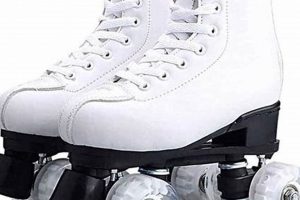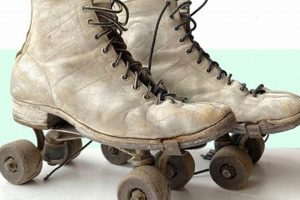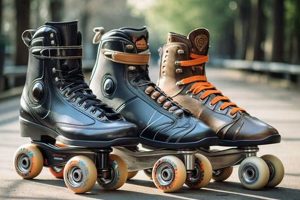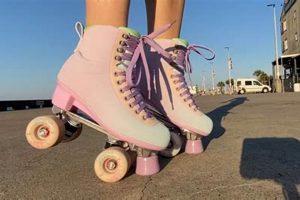Roller skates, footwear designed for gliding movement, encompass a range of configurations, each suited to particular activities. These rolling mechanisms, typically affixed to a boot or shoe, facilitate motion across flat surfaces. A common example includes quad skates, characterized by two wheels in the front and two in the back, offering stability for beginners. Inline skates, conversely, feature wheels arranged in a single line, allowing for greater speed and maneuverability.
The variety in roller skate designs provides options tailored to diverse skill levels and skating disciplines. This specialization enhances performance and user enjoyment. Historically, the evolution of these wheeled boots reflects a continuous pursuit of improved control, comfort, and speed, leading to innovations in wheel materials, boot construction, and frame design. The ability to choose a skate type matched to a desired activity improves the skating experience and safety.
Understanding the nuances of these different models is essential for selecting the appropriate equipment. The subsequent sections detail several categories, including quad skates, inline skates, and specialized variations for artistic skating, roller derby, and off-road use. Examination of their specific features and ideal applications will assist in making informed purchasing decisions.
Guidance on Selecting Roller Skates
Choosing suitable roller skates necessitates careful consideration of skating style, skill level, and intended use. Optimal selection enhances performance, safety, and overall enjoyment.
Tip 1: Determine the Primary Skating Style: Identify whether recreational skating, artistic skating, roller derby, or aggressive skating will be the dominant activity. Each discipline benefits from specific skate features.
Tip 2: Consider Skill Level: Beginners often benefit from quad skates due to their inherent stability. Experienced skaters may prefer inline skates for speed and maneuverability.
Tip 3: Evaluate Boot Comfort and Support: A well-fitting boot is crucial for preventing blisters and providing adequate ankle support. Consider heat-moldable boots for a customized fit.
Tip 4: Assess Wheel Hardness and Size: Harder wheels are faster and more durable, suitable for smooth surfaces. Softer wheels offer better grip and are appropriate for rougher terrain. Wheel size impacts speed and agility.
Tip 5: Examine Frame Material: Aluminum frames are lighter and more responsive than plastic frames, enhancing performance for advanced skaters. Plastic frames offer cost-effectiveness for beginners.
Tip 6: Inspect Bearing Quality: Higher ABEC ratings indicate tighter tolerances and smoother rolling. Consider investing in high-quality bearings for improved performance and longevity.
Tip 7: Prioritize Safety Equipment: Always wear a helmet, wrist guards, elbow pads, and knee pads to minimize the risk of injury, regardless of skill level or skating environment.
Proper selection of rolling boots significantly impacts the skating experience. Addressing the elements outlined above can result in a satisfying purchase.
The subsequent sections will delve into the various models, including inline and quad varieties, providing a more nuanced comparison.
1. Quad (four-wheeled)
Quad skates represent a foundational archetype within the broader category of rolling boots. Their distinctive configuration, featuring two wheels positioned at the front and two at the rear, contributes significantly to their handling characteristics and suitability for certain applications.
- Stability and Balance
The quad arrangement inherently provides a wider base of support compared to inline variations. This increased stability makes them particularly well-suited for beginners or individuals prioritizing balance, such as in recreational skating or roller derby. The lateral wheel placement facilitates easier weight distribution and control.
- Maneuverability and Agility
While not optimized for pure speed, quad skates excel in maneuverability, especially in environments requiring frequent turns and quick stops. The wheel configuration enables pivoting and lateral movements not as easily achievable on inline designs. Roller derby, for example, leverages this agility for strategic blocking and positional play.
- Boot Design and Comfort
Quad skates often incorporate boot designs emphasizing comfort and support. Traditional leather boots, coupled with a wide base plate, provide a secure and cushioned fit. This construction reduces fatigue during extended use, particularly relevant for recreational skating and dance-oriented activities.
- Historical Significance and Popularity
Quad versions possess a rich history as one of the earliest rolling boot designs. Their enduring popularity stems from their user-friendliness and versatility. They remain a common choice for indoor rink skating, roller discos, and various recreational pursuits due to their balance of stability, maneuverability, and affordability.
The characteristics discussed above underscore the importance of quad models within the spectrum of rolling boot designs. Their inherent stability, maneuverability, and comfortable design render them a versatile option for diverse users and skating environments. Understanding these facets enhances the ability to make informed equipment choices within the context of overall wheeled boot types.
2. Inline (single-line)
Inline skates represent a distinct and widely recognized type within the overall categorization of roller skates. Characterized by their configuration of wheels aligned in a single line, inline skates offer performance attributes divergent from their quad counterparts. Their design influences speed, maneuverability, and suitability for various skating disciplines.
- Speed and Efficiency
The inline arrangement promotes greater efficiency and speed compared to quad configurations. The linear wheel alignment minimizes rolling resistance, allowing for more effortless forward propulsion. This characteristic renders them suitable for speed skating, fitness skating, and long-distance skating where sustained velocity is paramount.
- Maneuverability and Edge Control
While stability may be initially more challenging for beginners, inline skates provide advanced maneuverability and edge control capabilities. The single line of wheels enables sharper turns, more precise edging, and the execution of complex maneuvers often seen in figure skating or aggressive skating. Skilled skaters leverage these attributes for intricate routines and technical maneuvers.
- Variations in Boot and Frame Design
Inline skates exhibit significant variations in boot and frame design tailored to specific applications. Aggressive skates feature reinforced boots and grind plates for performing tricks. Hockey skates provide ankle support and responsiveness for quick turns and stops. Fitness skates prioritize comfort and breathability for extended use. These design adaptations optimize performance within specific skating disciplines.
- Popularity and Applications
Inline skates have achieved widespread popularity in various skating contexts, including recreational skating, fitness training, competitive speed skating, and urban skating. Their versatility and performance attributes have solidified their position as a prominent wheeled boot type, catering to diverse user needs and skill levels.
The aforementioned qualities emphasize the unique position of inline models within the spectrum of rolling boot designs. Speed, maneuverability, and design adaptability contribute to their appeal across numerous skating environments. Understanding these attributes enables more informed decisions regarding rolling boot selection.
3. Artistic (dance-focused)
Artistic skating represents a specialized discipline within the broader categorization of rolling boots, characterized by its fusion of athletic prowess and aesthetic expression. The demands of artistic skating necessitate skate designs engineered for precision, agility, and control. The connection between artistic skating and rolling boot types is causal; the specific requirements of dance-focused performance dictate the design and construction of the skates used.
Artistic skating boots, typically employed in this discipline, prioritize ankle support and freedom of movement. A rigid boot structure, often crafted from leather or synthetic materials, provides the necessary stability for executing intricate spins, jumps, and footwork. The heel height and boot flexibility are optimized for balance and controlled transitions between edges. The plates, which connect the boots to the wheels, are designed for precise adjustments, allowing skaters to fine-tune their center of gravity and responsiveness. The wheels themselves are selected based on surface conditions and desired grip characteristics, often featuring a narrower profile for enhanced agility. For example, Riedell and Sure-Grip are manufacturers that specifically design and sell skate equipment for artistic (dance-focused) roller skating. The absence of specialized skating designs tailored to artistic expression would severely limit, if not preclude, the execution of complex routines and technical elements characteristic of the sport. The equipment facilitates the physical expression of the sport.
Ultimately, the relationship between artistic skating and rolling boot types is one of interdependence. The demands of artistic performance drive innovation in skate design, while advancements in skate technology, in turn, expand the possibilities for artistic expression. A comprehensive understanding of this connection is essential for selecting equipment that maximizes performance potential and minimizes the risk of injury. Challenges include finding the ideal balance between support and flexibility, as well as adapting to evolving performance standards and judging criteria within the artistic skating community. The importance of artistic (dance-focused) as a component of rolling boot types cannot be understated; it represents the diversity and innovation within the entire landscape.
4. Derby (contact-oriented)
Roller derby, a contact sport played on quad skates, fundamentally shapes the requirements and design of specific roller skate types. The aggressive nature of the sport, characterized by frequent collisions, rapid acceleration, and sharp turns, necessitates equipment built for durability, maneuverability, and protection. Consequently, derby-specific roller skates represent a distinct category, optimized for the unique demands of the game. For instance, reinforced boots provide enhanced ankle support to withstand lateral forces encountered during gameplay. Low-profile plates lower the skater’s center of gravity, improving stability and agility. Wheel durometers are carefully selected to balance grip and roll on the banked or flat tracks commonly used in roller derby. High-quality bearings ensure smooth wheel rotation under high-stress conditions. Without such specialized equipment, skaters would be at increased risk of injury, and their performance would be significantly compromised.
The practical significance of understanding the connection between roller derby and roller skate types extends beyond equipment selection. Coaches and team managers must be knowledgeable about skate components and their impact on skater performance to provide appropriate guidance and training. Referees need to understand the equipment regulations and safety standards to ensure fair play and prevent injuries. Roller derby leagues often collaborate with skate manufacturers to develop and refine equipment based on feedback from skaters and coaches. This iterative process leads to continuous improvements in skate design and performance. The rise in popularity of quad skates in roller derby is due to the agility, stability, and durability they offer players in this contact sport. Furthermore, protective gear, such as helmets, mouthguards, and pads, plays an equally important role in injury prevention during high-impact gameplay. So, understanding the impact the rolling boots has on the game as well as protective gear plays a vital role in the success of a roller derby team.
In summary, the relationship between roller derby and roller skate types is a direct consequence of the sport’s inherent physical demands. Derby-specific skates are engineered to provide the necessary protection, maneuverability, and performance characteristics to withstand the rigors of gameplay. The ongoing collaboration between skaters, coaches, and manufacturers ensures continuous innovation and refinement of roller skate technology. Challenges include balancing skate weight and durability, optimizing wheel performance for different track surfaces, and mitigating the risk of impact-related injuries. Despite these challenges, the continued development of derby-specific skates reflects the commitment to safety and performance within the roller derby community. The existence of “Derby (contact-oriented)” as a component of “types of roller skates” highlights the diverse applications of roller skates and the specialization required to meet the needs of specific skating disciplines.
5. Aggressive (trick performance)
Aggressive skating, a discipline focused on performing tricks and stunts, represents a specialized area within roller skating. The rigorous demands of this activity necessitate specific features in skate construction, distinguishing aggressive skates as a distinct type within the broader category. These skates are engineered for durability, impact resistance, and precise control during complex maneuvers.
- Reinforced Boot Construction
Aggressive skates feature heavily reinforced boots made from durable materials such as hard plastics or composite materials. This robust construction provides critical ankle support and protects the skater’s feet from impacts during landings and grinds. Internal padding cushions the foot, enhancing comfort and reducing the risk of injury. For example, specific brands like Razors or USD (Universal Skate Design) are known for their robust boot designs catering specifically to the impacts expected in aggressive skating. The boot is designed to take a beating so the skater’s foot doesn’t have to.
- Durable Frame and Grind Plates
The frame, connecting the boot to the wheels, is typically made from high-strength composite or metal to withstand the forces exerted during grinds on rails, ledges, and other surfaces. Grind plates, integrated into the frame or boot, provide a smooth, durable surface for sliding. These plates are often replaceable, allowing skaters to customize their skates based on their preferred style of grinding. Aggressive skate frames are typically shorter than those on fitness or speed skates to enhance maneuverability in tight spaces. The durability of the frame ensures that the energy transferred during trick performance doesn’t lead to equipment failure.
- Small, Hard Wheels
Aggressive skates utilize small, hard wheels, typically ranging from 55mm to 60mm in diameter and with a durometer (hardness) of 88A to 92A. These hard wheels provide minimal rolling resistance, allowing for quick acceleration and precise control during tricks. The small size enhances maneuverability and allows skaters to lock into grinds more easily. The wheels are optimized for sliding and performing tricks rather than covering distance efficiently. The hard wheels contribute to the overall responsiveness and control required for executing complex maneuvers.
- Bearing Quality and Configuration
While bearing ABEC ratings are less critical than in speed skating, the bearings in aggressive skates must be durable enough to withstand the impacts and stresses of trick performance. Configurations with larger gaps between the bearings may be employed to provide additional cushioning and reduce the risk of bearing damage during landings. The emphasis is on reliability rather than pure speed. Well-maintained bearings ensure smooth wheel rotation and contribute to the overall performance and safety of aggressive skates.
The unique combination of features found in aggressive skates reflects the specific demands of trick-based skating. The reinforced construction, durable frame components, small hard wheels, and reliable bearings work together to enable skaters to perform a wide range of tricks and stunts safely and effectively. Understanding these specific requirements is crucial for selecting appropriate equipment for aggressive skating and appreciating its unique place within the diverse landscape of roller skating disciplines. The modifications, upgrades, and brand-specific designs emphasize the importance of the trick performance category to the roller skating market.
6. Off-road (all-terrain)
Off-road roller skates represent a specialized adaptation within roller skate types, designed for traversing surfaces beyond smooth pavement. The connection between this category and the broader spectrum of rolling boots lies in the intentional modification of standard skate features to accommodate uneven terrain. This adaptation stems from the inherent limitations of conventional skates on surfaces such as grass, dirt trails, and gravel. As a result, all-terrain skates incorporate larger, pneumatic tires, robust frames, and modified boot structures to ensure stability, traction, and rider comfort. The cause-and-effect relationship is direct: the desire to skate on varied surfaces necessitates the development of specialized skate designs.
The importance of off-road roller skates within the types of rolling boots hinges on their expansion of skating possibilities beyond urban environments. They cater to individuals seeking recreational opportunities in natural settings or engaging in cross-training activities. For example, the Skike v9 FIRE series incorporates air-filled tires, adjustable bindings, and a braking system, enabling users to navigate unpaved roads and forest trails. Another example is the Nordic Skates, which feature ski-like poles for propulsion and balance on off-road surfaces. The practical application of this understanding is evident in the growing availability of all-terrain skating events and tours, demonstrating the demand for equipment capable of handling diverse landscapes. Furthermore, the incorporation of suspension systems and reinforced components reflects an ongoing effort to enhance rider comfort and minimize the impact of uneven terrain on the skater’s body. For example, some designs incorporate shock-absorbing elements to reduce vibrations and fatigue during extended use.
In conclusion, off-road roller skates constitute a distinct segment within the roller skate market, driven by the desire to extend skating beyond conventional paved surfaces. The adaptation of traditional skate designs to incorporate features suitable for all-terrain use highlights the ongoing innovation within the industry. Challenges remain in optimizing tire performance, frame durability, and rider comfort for various off-road conditions. Despite these challenges, the continued development and adoption of all-terrain skates reflect the growing appeal of exploring natural environments on wheels. This evolution underscores the expansive potential and diversity within rolling boot types, demonstrating the capacity of the technology to adapt to varied landscapes and user preferences.
7. Trainer (beginner-specific)
Trainer skates represent a specific adaptation within the taxonomy of roller skate types, prioritized for individuals new to the activity. The defining characteristic is the deliberate modification of standard features to enhance stability, control, and ease of use, facilitating a more positive initial skating experience. This specialization reflects the recognition that standard skate designs may present challenges for novices, increasing the risk of falls and hindering the development of fundamental skills. Consequently, beginner-specific models incorporate design elements aimed at mitigating these obstacles. For instance, wider wheelbases, adjustable speed controls, and enhanced ankle support are common features intended to promote balance and reduce the likelihood of injury. One example is the implementation of a speed-limiting mechanism, such as an adjustable brake or a restricted wheel rotation, allowing beginners to gradually acclimate to the sensation of rolling without experiencing excessive speed or loss of control. Another modification is the integration of higher ankle supports to prevent ankle twisting and subsequent injuries that often deter beginners.
The significance of trainer models as a component of roller skate types stems from their role in expanding accessibility to the sport. By addressing the specific needs and concerns of novice skaters, these models lower the barrier to entry, encouraging greater participation and promoting a positive perception of the activity. Furthermore, the development of beginner-specific designs has led to innovation in skate technology, influencing the design of other skate types as well. For example, features initially developed for trainer skates, such as adjustable wheel resistance or improved ankle support systems, have been incorporated into recreational and fitness skate designs to enhance user comfort and safety. One instance is the widespread adoption of padded liners and breathable materials in recreational skates, features initially popularized in trainer models to improve comfort for beginner skaters. Moreover, the focus on safety and ease of use in trainer designs has contributed to a greater awareness of the importance of proper skate fitting and maintenance, promoting a culture of safety within the skating community. For many roller skating organizations, encouraging access to the sport is a goal; thus, beginner-specific skates that reduce the risk of injury or lack of progress support the goal.
In summary, trainer skates constitute a distinct category within the broader spectrum of roller skate types, characterized by their intentional adaptation for beginner skaters. The incorporation of features such as wider wheelbases, speed-limiting mechanisms, and enhanced ankle support reflects a commitment to promoting stability, control, and ease of use. The practical significance of this specialization lies in its role in expanding accessibility to the sport, encouraging greater participation, and promoting a positive perception of roller skating among novice skaters. Challenges include balancing the need for enhanced stability with the desire to develop proper skating technique and transitioning from trainer skates to more advanced models as skills improve. Despite these challenges, the continued development and refinement of trainer skate designs underscore the importance of catering to the specific needs of beginner skaters and fostering a lifelong appreciation for the activity. The inclusion of trainer-specific rolling boots emphasizes the importance of acknowledging and addressing the challenges faced by newcomers to the sport, fostering a more inclusive and supportive skating environment.
Frequently Asked Questions
This section addresses common inquiries regarding the selection and application of various roller skate models.
Question 1: What distinguishes quad skates from inline skates?
Quad skates possess two wheels in the front and two in the rear, offering enhanced stability, particularly beneficial for beginners. Inline skates feature wheels aligned in a single row, promoting greater speed and maneuverability.
Question 2: Are artistic skates suitable for recreational use?
Artistic skates, designed for dance and performance, prioritize ankle support and maneuverability. While usable for recreation, their specialized design may not provide optimal comfort for prolonged, casual skating.
Question 3: What factors should be considered when choosing roller derby skates?
Roller derby skates require robust construction to withstand physical contact. Key considerations include reinforced boots, low-profile plates for stability, and durable wheels optimized for indoor surfaces.
Question 4: How do aggressive skates differ from other types?
Aggressive skates are engineered for trick performance, featuring reinforced boots, grind plates for sliding, and small, hard wheels for enhanced control during stunts.
Question 5: Can off-road skates be used on paved surfaces?
Off-road skates, designed for uneven terrain, can be used on pavement. However, their larger, pneumatic tires may result in reduced speed and maneuverability compared to skates designed specifically for smooth surfaces.
Question 6: What are the key features of beginner-specific roller skates?
Trainer models prioritize stability and control, often incorporating wider wheelbases, adjustable speed controls, and enhanced ankle support to facilitate a positive initial skating experience.
Careful consideration of the intended use and skating environment is crucial for selecting the appropriate roller skate type. Each design offers specific advantages tailored to different disciplines and skill levels.
The following section will provide resources for finding the right roller skates based on the different types available.
Conclusion
This exploration has delineated the diverse spectrum of roller skate types, encompassing quad, inline, artistic, derby, aggressive, off-road, and trainer models. Each category reflects specialized engineering and design adaptations tailored to specific skating disciplines and skill levels. Understanding these nuanced distinctions is essential for informed equipment selection.
The continuous evolution of roller skate technology mirrors the dynamic nature of skating itself. Whether pursuing recreational enjoyment, competitive performance, or innovative exploration, recognizing the inherent characteristics of each rolling boot type empowers individuals to optimize their skating experience. Continued advancements in materials, design, and safety features promise to further refine and expand the possibilities within the realm of roller skating.







